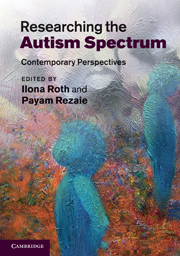Book contents
- Frontmatter
- Contents
- Preface
- Foreword
- List of Contributors
- Introduction
- Part I Classification and Diagnosis
- Part II Genetics, Neurology and Biochemistry
- Part III Cognition, Development and Education
- 7 Psychological models of autism: an overview
- 8 Cognitive flexibility in autism: a social-developmental account
- 9 Language in autism spectrum disorders
- 10 Memory in autism: binding, self and brain
- 11 Measuring executive function in children with high-functioning autism spectrum disorders: what is ecologically valid?
- 12 Autism spectrum disorders in current educational provision
- Index
- Plate section
- References
8 - Cognitive flexibility in autism: a social-developmental account
Published online by Cambridge University Press: 04 February 2011
- Frontmatter
- Contents
- Preface
- Foreword
- List of Contributors
- Introduction
- Part I Classification and Diagnosis
- Part II Genetics, Neurology and Biochemistry
- Part III Cognition, Development and Education
- 7 Psychological models of autism: an overview
- 8 Cognitive flexibility in autism: a social-developmental account
- 9 Language in autism spectrum disorders
- 10 Memory in autism: binding, self and brain
- 11 Measuring executive function in children with high-functioning autism spectrum disorders: what is ecologically valid?
- 12 Autism spectrum disorders in current educational provision
- Index
- Plate section
- References
Summary
There are important social-developmental contributions to the acquisition of flexible, generative, context-sensitive thinking and engagement with the world. We highlight how among individuals with autism, limitations in the propensity to identify with the attitudes of other people might lead to a paucity of movement across alternative ‘takes’ on the world, and with this, specific forms of cognitive restriction and rigidity.
Introduction
Consider this condensed version of a classic description of a person with autism called L (Scheerer et al. 1945). L was first seen at the age of 11 with a history of severe learning difficulties. He was said never to have shown interest in his social surroundings. Although he had an IQ of only 50 on a standardised test of intelligence, L could recount the day and date of his first visit to a place, and could usually give the names and birthdays of all the people he met there. He could spell forwards and backwards.
L's background history included the fact that in his fourth and fifth years he rarely offered spontaneous observations or reasons for any actions or perceived event. Nor would he imitate an action of others spontaneously. He was unable to understand or create an imaginary situation. He did not play with toys, nor did he show any conception of make-believe games. He was unable to converse in give-and-take language. He barely noticed the presence of other children, and was said to have ‘little emotionality of normal depth and coherence’.
- Type
- Chapter
- Information
- Researching the Autism SpectrumContemporary Perspectives, pp. 266 - 283Publisher: Cambridge University PressPrint publication year: 2011
References
- 1
- Cited by



